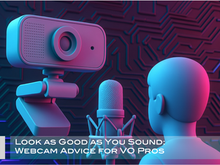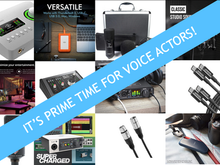Think Outside The Box: Voice Booth Considerations when Options are Limited
- Frank Verderosa
- Jan 29, 2024
- 6 min read

Tight spaces are the enemy of good voice recording, perhaps second only to parallel surfaces. Why then do so many prefabricated booths come in squares and rectangles, and why do booth-builders often default to those shapes? Sure, you can ultimately treat the interior to make it work- but I would argue that when making a booth, you have a unique opportunity to fix this issue at the planning stage. It might be more work for your contractor- but the benefits would be great! So what's the issue with parallel walls?
Parallel surfaces can adversely impact acoustics by causing sound reflections that lead to unwanted effects such as flutter echoes and standing waves. When sound waves bounce back and forth between parallel surfaces, they can reinforce certain frequencies, creating peaks and nulls in the frequency response. This phenomenon, known as room modes, results in an uneven distribution of sound, compromising the overall acoustic quality. Additionally, parallel surfaces can contribute to a lack of sound diffusion, making the space sound more reflective and less natural. To optimize acoustics, designers often introduce non-parallel surfaces, diffusers, and absorptive materials to minimize these detrimental effects.
Your closet may be too thin, or too shallow to fit in comfortably AND get a decent sound. But what if that closet became just a part of your booth?
Think about the recording booths you've been in. You'll notice one glaringly obvious hard, flat surface as soon as you walk in. The window to the control room! Sometimes those windows might be relatively small, but more often than not they're quite large. If you look closely, you'll notice they are installed on an angle. Look even closer, and you'll notice that the double pane on the control room side of the booth is also on an angle. This helps the acoustics in both rooms.

If you're trying to figure out a space to record in as a working or aspiring voice actor, you'll probably gravitate toward a closet. I say it time and time again, and those of you who have attended my Home Studio Primer class have certainly heard it: walk-in closets are God's gift to voice actors. If you live in a quiet place away from the big city, and you've got large closet, you may not have to do much at all to have a bookable booth. Bonus points if it's carpeted. Extra bonus points if there's already a light installed overhead. And having outlets is the trifecta of awesome. Often times when I work with people to plan their recording space, they'll bring me into their closet and say something like "Apologies for all the messy clothes!", to which I reply "You mean acoustic absorbers!". The fact is that those racks of shirts, folded up and stacked seasonal blankets and comforters and winter coats all do a great job soaking up reflections in your larger closet. Those racks of shoes, boxes of junk and other odds and ends become natural acoustic diffusers. Very often the only concern you might have making a walk-in closet into a booth is aesthetic. I joke all the time about wanting to make a sheet with a realistic printout of a professional booth for actors to hang behind them when on Zoom calls and they're feeling self-conscious about their space (patent pending!!).
Tiny Closet- Big Problems

If walk-in closets are God's gift to voice actors, tiny closets are the are the road to hell. When people inquire about converting a closet to a booth, and then give me measurements at or slightly above 2 feet by 2- I instantly begin explaining "Plan B". If you have literally no other option, you can struggle to make that space ALMOST work, but there will be no amount of padding that will kill the inevitable comb filtering you will hear.
Comb filtering is an audio phenomenon caused by the interference between a direct sound wave and its delayed reflection. The resulting frequency response exhibits alternating peaks and nulls, resembling a comb. This can occur when identical audio signals overlap with a slight delay, causing cancellations and distortions, degrading overall sound quality. In plain terms: you're booth will be boxy as hell.
There are things you can try to mitigate it. A shotgun mic will sound a little better than some of the large diaphragm condenser mics and other cardioid patterns. You can try your hardest to deaden the walls and move the mic as far as possible from any surface. But... you also need room to work. And BREATH! These are the reasons I try to talk people out of using small closets.
"So what the heck am I Supposed to do?"

This is where we think OUTSIDE the box. Your closet may be too thin, or too shallow to fit in comfortably AND get a decent sound. But what if that closet became just a part of your booth? Pictured here is a plan beautifully executed by New York based voice actor Ildi Kiss. She had a closet type that I see often- not terribly deep... decently wide. Squeezing in there to work sideways (which people often do) would be a challenge for a lot of people. However, in consulting on a plan, I noticed that the doors open outward. That was an opportunity to treat them as walls and add more working space.
To give the "booth" even MORE room, we opted to hang a set of Producer's Choice acoustic blankets on a ceiling track that extends beyond the closet and around the adjacent wall. When it's time to work- simple open the closet, close the curtains, and you've got an acoustically dead space to work in without your mic being too close to any boundaries. When you're done, simply put everything back in the closet, close the doors, and slide the curtain back against the wall. Obviously plans like this aren't going to be soundproof. In my experience, very few people have the space or budget to sort out a truly sound proof space that is also acoustically viable. In my Home Studio Primer I show some amazing examples of what I've helped people create.
"Great, but I don't even have THAT!"
I get it. Lots of people live in small spaces. The idea of even having a booth when you're living in a studio apartment in Manhattan seems crazy. And truly it is- because when you live in a city where a lot of the work is being done, it seems absurd to be told "must have a broadcast quality studio" when the company recording it is a subway ride away. But that's another whole blog post! So what else can you do?
For about $1500, Vocal Booths to Go makes a collapsable metal frame with pre-cut acoustic blankets to keep it neat. They even give you a little plastic window for some light! For a third the price ($499.99), you could consider a SnapStudio booth. That gives you a ready-to-assemble, sturdy PVC pipe frame with pre-cut acoustic blankets, including a floor and ceiling cover. They also throw in a rechargeable LED light bulb to hang, and an Ipad holder that mounts to the frame. They come in standard and XL for more space.
Now- you might look at this and think "Wait, 33"x 33" is like having a small closet! Isn't that a problem?". The answer is no- not if you're assembling it in a larger room. Because there are no hard surfaces for the sound to bounce back from, you don't get the same comb filtered "boxy" sound. These are best used in an already quiet room, preferably carpeted and furnished. If you assemble it in a larger empty room with hard floors and untreated walls, it will only be effective on very quiet reads. The minute you speak up, the reflections from outside the booth will work their way into your sound- especially for animation and video game reads.
There's a Solution for Everyone!
It's my hope that this article helps to get you thinking about which options might work best for your space. I always say there is a something for everyone. Sometimes we just need to think about it and plan strategically. If you want help, feel free to reach out for a Booth Consult (hit the VO HELP tab above), and we can come up with a plan of attack for your gear and space to make sure you sound your best!





























ilda kiss’ city booth is genius!